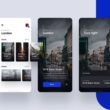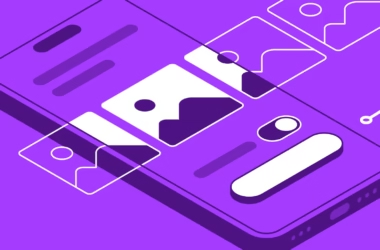Many aspiring designers misunderstand the term UI/UX, thinking it’s a single concept. When they search for “UIUX” on Google, they often expect a straightforward definition but end up confused by the variety of explanations. The reason is that UI and UX are two distinct but related fields, each with its own role in the design process. UI (User Interface) focuses on the visual aspects, while UX (User Experience) deals with the overall feel and functionality of a product. Understanding this distinction is crucial for anyone looking to enter the field of design.
What is UX Design?
User Experience (UX) design is the process of creating products that provide meaningful and enjoyable experiences for users. It focuses on how a product feels and how easy it is to use. UX design ensures that users can navigate and interact with a product effortlessly.
Example: Imagine you’re using an e-commerce website. If it’s hard to find products, the checkout process is confusing, or pages take too long to load, the UX is poor. A well-designed UX makes shopping easy, with intuitive navigation and a smooth checkout process.
What is UI Design?
User Interface (UI) design is about the look and feel of a product. It involves designing screens, buttons, icons, typography, and colors to create a visually appealing and functional experience. UI design ensures that users enjoy using a product while maintaining a consistent style.
Example: Think of Instagram. The clean layout, recognizable icons, and smooth animations make interactions pleasant. The UI designer ensures that buttons, fonts, and colors create an attractive and engaging experience.
What is a UX Designer, and What Do UX Designers Do?
A UX designer is responsible for making products easy to use, accessible, and engaging. They conduct research to understand users’ needs, create wireframes and prototypes, test designs, and work with developers to build the final product. Their main goal is to enhance user satisfaction.
Example: A UX designer working on a food delivery app will research how users order food, create wireframes to simplify the ordering process, and test the design with real users to ensure a smooth experience.
What Skills Do UX Designers Need?
- User research and analysis: Understanding users’ needs through surveys, interviews, and analytics.
- Wireframing and prototyping: Creating blueprints (wireframes) and interactive models (prototypes) of the product.
- Usability testing: Testing designs with real users to find and fix issues.
- Information architecture: Organizing content logically so users can find what they need.
- Problem-solving and critical thinking: Analyzing user problems and designing solutions.
- Communication and collaboration: Working with developers, stakeholders, and designers.
- Basic coding knowledge (HTML, CSS, JavaScript – optional but useful): Helps in better collaboration with developers.
What is a UI Designer, and What Do UI Designers Do?
A UI designer focuses on the visual elements of a product. They create attractive interfaces, ensuring consistency in color schemes, typography, and layout. UI designers work closely with UX designers and developers to bring the best user experience to life.
Example: A UI designer working on a fitness app will choose colors, fonts, and icons that create a motivating and visually appealing experience while ensuring buttons and text are easy to read and use.
What Are the Different Types of UI?
- Graphical User Interface (GUI): Used in websites and apps (e.g., buttons, icons, and menus). Example: Windows and Mac operating systems use GUI.
- Voice User Interface (VUI): Interaction through voice commands (e.g., Alexa, Siri). Example: Asking Google Assistant to set an alarm.
- Gesture-Based Interface: Uses motion sensors for interaction (e.g., VR applications). Example: Using hand gestures in virtual reality games.
- Command-Line Interface (CLI): A text-based interface for typing commands (used by developers and system admins). Example: Typing “cd Documents” in a terminal to navigate to a folder.
What Skills Do UI Designers Need?
- Visual design principles (color theory, typography, layout): Understanding how colors, fonts, and composition affect usability and aesthetics.
- Prototyping and wireframing tools (Figma, Sketch, Adobe XD): Creating interactive UI designs to visualize user flows.
- Branding and consistency: Ensuring a product maintains a unified look and brand identity across screens and devices.
- Interaction design: Designing UI elements that respond to user inputs smoothly and intuitively.
- Animation and micro-interactions: Enhancing user engagement with subtle motion effects, like button hover states or loading animations.
- Basic coding knowledge (optional but helpful): Understanding front-end technologies like HTML, CSS, and JavaScript to collaborate effectively with developers.
- Accessibility design: Ensuring designs are usable for people with disabilities, following WCAG (Web Content Accessibility Guidelines).
- Responsive design: Adapting designs for various screen sizes, from mobile devices to large monitors.
What’s the Difference Between UX and UI?
| Feature | UX Design | UI Design |
|---|---|---|
| Focus | User experience and usability | Visual and interactive design |
| Responsibilities | Research, wireframing, usability testing | Designing the look and feel |
| Goal | Making the product functional and easy to use | Making the product visually appealing |
| Tools | Figma, Adobe XD, Axure | Figma, Sketch, Adobe Photoshop |
Example: A UX designer ensures an online banking app’s flow is easy to use, while a UI designer makes sure the buttons, colors, and fonts look professional and trustworthy.
What is a UX/UI Designer?
A UX/UI designer combines both UX and UI skills. They design both the usability and appearance of a product. These designers work on the full design process, from research to final visuals, ensuring a seamless user experience.

Is UX/UI Design a Good Career?
Yes! UX/UI design is a highly rewarding career because:
- High demand in various industries (tech, healthcare, e-commerce, etc.).
- Good salaries and career growth opportunities.
- It combines creativity with problem-solving.
- Remote work and freelance opportunities are available.
What is the Salary of a UX/UI Designer?
Salaries vary by location and experience:
United States:
- Entry-Level (0-1 years): $50,000 – $70,000 per year.
- Junior (1-3 years): Around $72,500 per year.
- Mid-Level (3-8 years): Approximately $100,000 per year.
- Senior (8+ years): Around $120,000 per year.
Nigeria:
- Entry-Level: ₦100,000 – ₦250,000 per month.
- Mid-Level: ₦250,000 – ₦500,000 per month.
- Senior-Level: ₦500,000 – ₦1,000,000+ per month.
How Do I Become a UX/UI Designer?
- Learn the Basics: Take online courses (Coursera, Udemy, Google UX Design Course).
- Develop Your Skills: Practice wireframing, prototyping, and UI design.
- Use Design Tools: Get familiar with Figma, Sketch, and Adobe XD.
- Build a Portfolio: Work on projects and showcase your designs.
- Gain Experience: Freelance, intern, or work on personal projects.
- Apply for Jobs: Look for UI/UX design roles at startups, agencies, or large companies.
FAQs About UX/UI Design
1. Do I need a degree to become a UX/UI designer?
No, a degree is not required. Many designers enter the field through online courses, bootcamps, and self-learning.
2. How long does it take to learn UX/UI design?
It depends on your learning pace. Some bootcamps last 3-6 months, while self-taught learners may take 6 months to a year.
3. What tools do UX/UI designers use?
Common tools include Figma, Sketch, Adobe XD, Axure, and InVision for design and prototyping.
4. Can I be both a UX and UI designer?
Yes, many designers work in both roles, but some specialize in one area.
5. Is coding required for UX/UI design?
No, but basic knowledge of HTML, CSS, and JavaScript can be helpful.
6. Can I work remotely as a UX/UI designer?
Yes, many companies hire remote designers, and freelancing is also an option.
7. What industries hire UX/UI designers?
Industries like tech, healthcare, finance, e-commerce, and entertainment all hire UX/UI designers.
8. What’s the best way to get started in UX/UI design?
Start by learning design principles, taking online courses, building projects, and creating a portfolio.
UX/UI design is an exciting and growing field with many opportunities. Whether you’re new to design or looking to switch careers, there’s never been a better time to explore UX/UI!










This is super amaizing